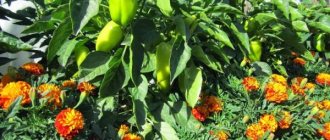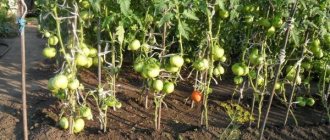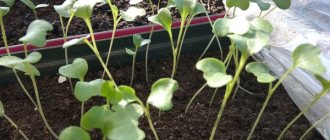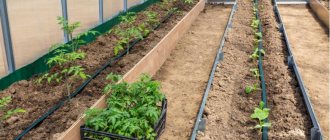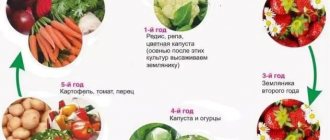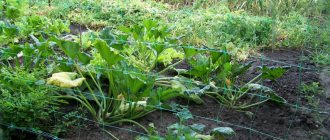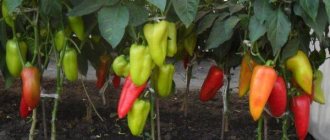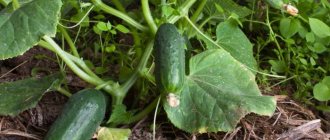Experienced summer residents know well that planting vegetables in the same place for several years in a row is taboo. Each vegetable absorbs from the soil substances that are necessary for its full development. Next year, their reserves are exhausted, which leads to a reduction in yield and the production of small fruits. To avoid such a problem, it is necessary to carry out crop rotation of vegetable crops annually.
It is important to pay special attention to choosing a new place for vegetables. You also need to find out which predecessors are not prohibited. Today's article will touch on the topic of onions. What can be planted after this vegetable and whose place can it take?
54
Is it possible to plant onions after onions?
Proper crop rotation when planting onions - after harvesting, the bed should rest for 3 years before the same crop is replanted on it. Causes:
- soil fatigue;
- common pathogens and pests.
Each plant selects from the soil those elements and substances that are necessary for its growth and maturation. If you plant onions after onions, the soil is significantly depleted, and even the richest fertilizers will not replenish the reserves of useful components that onions “suck” from the soil.
Visually, this can be determined by the fact that the yield in the beds becomes lower, and the bulbs themselves become smaller, their taste deteriorates and the content of nutrients decreases. This phenomenon is called soil fatigue.
Onions, like all crops, have their own pests and diseases:
- downy mildew;
- fusarium rot;
- pink root rot;
- onion fly;
- onion thrips, etc.
Pathogens and pest larvae overwinter in the soil (they remain there in small quantities even after the most correct treatment for the winter) and wait for “their host” - a crop on which they can feed and reproduce. When sowing onions annually in the same bed, the mass of harmful microflora will rapidly approach critical.
Why is it important to follow them?
The main reasons why crop rotation is necessary:
- Proper rotation of crops maintains soil fertility.
- The principle of crop rotation prevents the accumulation of pathogens and insect pests.
- Proper planting of crops helps improve soil health.
Planting the same plant in the same bed for several years will lead to soil depletion . In addition, pathogens characteristic of this crop will intensively develop in it.
Some plants not only do not deplete the soil, but, on the contrary, saturate it with nutrients. These plants include legumes, green manure and winter crops. After them, the soil is rich in nitrogen and other useful compounds.
What to plant after onions next year?
They grow well in beds where onions were planted a year earlier:
- pumpkin (cucumber, pumpkin, zucchini, squash, zucchini, and melon);
- legumes (beans, peas, chickpeas (peas), soybeans);
- nightshades (tomatoes, potatoes, hot peppers, sweet peppers);
- root vegetables: carrots, turnips and beets.
These garden crops are immune to onion pests and diseases, and the composition of the soil after onions satisfies all the nutritional needs of these plants. But this does not relieve gardeners from the need to treat the soil from weeds after harvesting and before planting and to feed the crops with fertilizers, both organic and mineral.
And immunity to onion pests does not mean that the plant will automatically not suffer from its characteristic “sores.” Therefore, no one canceled pest control.
It is interesting that legumes and turnips, which grow well in areas after onions, do not feel the best when planted next to them.
Another interesting fact concerning not only onions, but also root crops: if a crop with fruit in the ground (root crop, onion) was grown in a garden bed, the crop with fruit on branches (tomatoes, beans, strawberries, peppers) and vines grows well after it ( cucumbers, zucchini, melons).
Vegetable crop rotation scheme: table
The best predecessors before planting onions
The best predecessors for onions are:
- zucchini;
- green manure;
- beans;
- beans;
- peas;
- early potatoes;
- cucumbers;
- pumpkin;
- cabbage.
After these plants, the onion will not only grow quickly, but will also delight you with a good harvest.
Also, favorable soil is considered to be one in which organic fertilizers were applied in large quantities before planting. After planting and during the growing season, organic matter is not added to the onion beds, as this harms the plant.
Winter sets are planted after corn, tomatoes, lettuce and cucumbers . A cold-resistant crop will sprout at an air temperature of +5…+7℃. But do not forget that the lower the temperature, the later the shoots will appear.
After what crops can onions be planted?
Planting onions is recommended in those beds where agricultural crops were planted with preliminary soil replenishment, as well as in areas after growing green manure crops (annual grasses, winter wheat, etc.)
But late varieties of onions develop very well where early ripening crops were previously grown.
What is the best time to plant onions?
The best effect on the germination of onions, its health and productivity are those predecessors for which the soil was richly amended for planting. This:
- early varieties of cabbage and other cruciferous vegetables;
- early varieties of potatoes;
- cucumbers;
- tomatoes;
- Bulgarian pepper.
You can take a break and instead of vegetables, sow cereal crops - green manure (rye, wheat), mustard, or marigolds in general: these flowers will not only decorate the site, but also a “doctor” for the soil, for its structure.
- Onions react well to soil where carrots were previously grown.
- By the way, these crops grow well if their beds are adjacent: they destroy each other’s pests. The same applies to dill.
- Onions go well with watercress, basil, mint, and grow well after them.
If we talk about winter onions, then it is best to plant seedlings before winter after cereals, tomatoes, beets, early varieties of cabbage and radishes, and cucumbers.
Planting is carried out if the harvest from the garden bed was collected before the beginning of August: the garden bed should dry out slightly and rest.
What can you plant after tomatoes?
Green manure
If mid-season or late-season onions were grown at the dacha, harvesting can begin at the end of August or beginning of September. The period of night frosts will soon begin, so it will not be possible to plant a new crop after the onions are harvested. To saturate the soil with useful substances and establish crop rotation, you can use green manure, which in everyday life is called “green doctors”. Their planting will allow:
- prevent weeds from appearing;
- fertilize the soil;
- fight pest larvae and pathogenic bacteria, which in turn will ensure cleansing and disinfection of the soil;
- carry out good loosening of the soil due to strong roots.
For each site you need to select a specific green manure. This plant is classified into 5 varieties. The cruciferous family saturates the soil with phosphorus, sulfur, and organic matter, and protects plant crops from wireworms, root rot, and nematodes.
The Asteraceae family is a source of complex, difficult to decompose organic fibers. Cereals will help fill the soil with potassium, nitrogen and organic matter. Buckwheat will saturate the soil with the same microelements as cereals.
What can't be planted after onions?
After onions, representatives of the onion family grow poorly:
- leek;
- chives;
- wild garlic;
- leek;
- garlic;
- shallots, etc.
If these crops are planted after onions, they will be extremely unstable to pathogens and pests. Beds in which onion crops have been alternated for more than two years will require 2 years of rest and restoration measures.
It is necessary not only to add humus and organic matter to the soil, but also to use potassium fertilizers and ready-made mixtures. It is also necessary to dig up such beds and get rid of weeds.
The same applies to flowers such as amaryllis, hyacinth, etc. They will not grow well in former onion beds.
Basic rules of crop rotation
The need to alternate the cultivation of different crops in the same place is caused by several reasons:
- Each plant species extracts a specific set of nutrients from the soil. If you constantly plant the same plant species or crops that have a similar need for basic nutrients in the same area, then the one-sidedly depleted soil will no longer be able to fully nourish these plants.
- On the other hand, if in a given area, after one crop, another with different preferences in the use of nutrients is planted, then, by consuming their unspent supply, it simultaneously allows the soil to replenish the lack of previously consumed elements.
- In addition, crop rotation allows you to avoid allelopathy, which consists in the negative impact of the remains of the predecessor’s root system on the roots of the subsequent plant, as happens, for example, with onions planted after carrots.
- Repeated cultivation of a particular plant in the same place contributes to the accumulation of pathogens and pest larvae in the soil, which attack plantings of the same type more and more aggressively with each season.
- The hollowing out of the soil, the extraction of a certain set of nutrients from it when constantly growing the same plant on it, cannot be corrected by intensive application of fertilizers, since the “bouquet” of nutrients extracted from the soil is extremely diverse and cannot be accurately calculated. But the predecessors and the most suitable successors in the form of vegetables and berries, determined empirically over many decades, cope with the task perfectly. Special crop rotation tables have been compiled, which indicate the predecessors and their corresponding successors.
Did you know? Although onions are known as bitter vegetables, their sugar content reaches 6%, surpassing even apples and pears in this regard. The sweetness of the onion is easy to verify when frying it.
After what vegetables should onions not be planted?
All representatives of the onion family are bad predecessors for each other, so do not plant onions in former garlic beds, after sowing other types of onions (chives, leeks, shallots) and where flowers of the amaryllis and lily genus were grown.
If onions are of early varieties, you should not make a bed where any vegetables of late varieties were collected in late autumn, even those whose earlier varieties have a beneficial effect on the growing season of onions - for example, late cabbage. In this case, the soil will not have time to recover.
It is not recommended to plant onions in the place where celery and sage grew, as well as asparagus.
Onions grow poorly in soil where the same crop has grown for more than three years. Such soil will need to be fertilized and allowed to rest.
Onions and strawberries
The onion family has its own relationship not only with vegetables, but also with berries. Such a popular garden crop as strawberries (strawberries) is very friendly to all types of onions. These crops can be planted in neighboring beds: they will protect each other. You can plant strawberries after onions.
It is better not to make strawberries as a direct predecessor for onions, but to take a year’s break. Strawberries have deep roots, and after the strawberry bed is dug up, it is better to plant legumes or pumpkins, the same cucumbers and zucchini with their superficial root system. And after these crops have been harvested, onions are planted in nitrogen-enriched soil.
What can be sown in August, after harvesting onions and garlic: video
Onion companion plants
Helpful neighborhood. Many people recommend planting garlic next to strawberries, but onions will also be an excellent neighbor for them. And it also feels good and does not interfere with almost all vegetable crops and herbs.
The exceptions are legumes and sage. For them, onions are a bad neighbor.
What vegetables can be planted nearby?
What soil and conditions do onions need?
Onions like the beds to warm up, so they are planted as seedlings in sunny or slightly shaded areas. The optimal soil for this crop is rich loam, not acidic, moderately moist, with good air permeability. You cannot plant onions:
- in the lowlands;
- in places where groundwater is high (it will rot);
- in cold soil;
- in acidic soil.
The last point can be corrected, but not on the eve of sowing: the acid is removed by liming, and this is done 2 years before planting the onions.
The beds where onions will be sown in the spring are dug up in the fall using a spade, carefully removing weeds and applying fertilizer. For 1 m2 you need:
- 5 kg of compost mass (or manure, but always stale!);
- 1 kg of ash.
Fresh manure as a fertilizer for onions is destructive: you should refrain from planting the crop even in cases where the bed was fertilized with such manure a year earlier. You can use ready-made mineral fertilizers for onions.
Spring reclamation work only involves lightly loosening the bed with a rake; if the soil becomes heavier, you can lightly dig up the top layer. Deep digging will disrupt the soil structure formed over the winter and speed up the evaporation of moisture. In spring, fertilizers are applied at a shallow depth so that the short roots of the onion can easily receive the nutrients they need for nutrition.
Although this is a fairly cold-resistant plant (adult onions tolerate ground frosts down to -5°C), it grows best in the temperature range from 12 to 26°C. Therefore, the optimal time for planting is the first ten days of May. Depending on the variety, the growing season for onions ranges from 3 months to six months.
- In normal warm weather, it is enough to water the onion beds once a week, and weed and loosen them with the same frequency.
- In hot and dry weather, you can do more frequent loosening (2 times a week) so that the soil does not become crusty.
- You need to watch the onion feather: if the tips begin to dry out, additional watering is needed.
- To avoid the accumulation of excess moisture in the soil and rotting of the roots, take a closer look at the color of the feathers: if they become pale green, there is a lot of water in the soil, you can wait a little longer with watering.
Rules for crop rotation when growing onions
Crop rotation implies proper alternation of crops, which reduces the risk of plant diseases and increases soil fertility.
Crops of the onion family feel good in non-acidic, moderately moist soil with good air permeability. The area where you plan to plant onions should be well heated by the sun. The culture does not like heavily shaded beds: lack of light has a bad effect on the size of the developing bulbs.
Onion beds should not be fertilized with fresh manure. The best fertilizers will be mineral fertilizers containing nitrogen, potassium and phosphorus and wood ash.
Reference ! Wood ash not only saturates the soil with useful substances, but also prevents the occurrence of fungal diseases.
If the soil is highly acidic, it is deoxidized by adding dolomite flour or slaked lime. Litmus paper will help determine the acidity level. To do this, dissolve a little earth in a glass of water and place an indicator in the solution. With increased acidity it will turn red.
Maintaining the soil in a consistently moist state will have a beneficial effect on crop yields, while excess moisture will lead to putrefactive processes.


